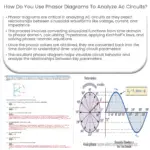A phasor diagram is a graphical representation of the magnitude and phase of sinusoidal waveforms in an AC circuit, used for analyzing circuit behavior.
Introduction to Phasor Diagrams
A phasor diagram is a graphical representation of the magnitude and phase of sinusoidal waveforms in an alternating current (AC) circuit. It provides a visual way to understand and analyze AC circuit behavior and is especially useful for solving circuits with impedance and phase relationships.
Phasors and Complex Numbers
Phasors are vector representations of sinusoidal functions that can be described using complex numbers. A complex number has a real part and an imaginary part, typically written in the form a + jb, where a and b are real numbers, and j is the imaginary unit, equal to the square root of -1. In the context of phasor diagrams, the real part represents the resistive component of a circuit, and the imaginary part represents the reactive component (inductive or capacitive).
Constructing a Phasor Diagram
- Convert all circuit elements into their phasor equivalents. This involves converting resistances, capacitances, and inductances into their corresponding impedance values.
- Express the voltages and currents as phasors. For each sinusoidal waveform, determine its magnitude and phase angle.
- Draw a coordinate system with a horizontal axis representing the real part and a vertical axis representing the imaginary part. This is known as the complex plane.
- Plot the phasors as vectors on the complex plane, with the tail of each vector at the origin. The length of the vector represents the magnitude, and the angle between the vector and the horizontal axis represents the phase angle.
- Perform calculations using vector addition, subtraction, and multiplication to solve for unknown values or analyze the circuit behavior.
Applications of Phasor Diagrams
Phasor diagrams are widely used in electrical engineering for analyzing AC circuits, especially those with multiple sinusoidal sources, impedances, and phase relationships. They provide a clear visual representation of the phase relationships between voltages and currents, enabling engineers to design and troubleshoot complex systems more effectively.
Limitations of Phasor Diagrams
It is important to note that phasor diagrams are only applicable to linear, sinusoidal systems. They are not suitable for analyzing circuits with non-sinusoidal waveforms, non-linear components, or time-varying elements. In such cases, alternative methods such as Fourier analysis, Laplace transforms, or numerical simulations may be more appropriate.




